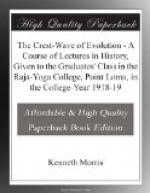His school remained esoteric; but it was established, not among the secret mountains, nor in far unvisited regions; but there in the midst of imperial China: an extension of the Lodge, you may say, visible among men. Bodhidharma—are you to call him a Messenger at all? He hardly came out into the world. It was known he was there; near by was the northern capital;—he taught disciples, when they had the strength to insist on it. Yet he dwelt aloof too, and wrapped about in the seclusion Masters must have, to carry on their spiritual work. One must suppose that Messengers of the Lodge had been very busy in China between 375 and 400, in the days of Tao Yuang-ming and Ku Kai-chih; that they had been very busy again in the last quarter of the fifth century; for it seems as if somehow or other there was such an atmosphere in China in the first half of the sixth century,—when ordinarily speaking the Doors of the Spiritual World would be shut,—that the Lodge was enabled partly to throw off its seclusion, and it was possible for at least one of its Members to take up his abode there, and to be known to the world as doing so.
A Messenger was sent out into the Chinese world from the School of Bodhidarma in 575: Chih-i, the founder of the Tientai School which was the spiritual force underlying the glory of the T’ang age; but he was a Messenger from the Dzyan School of Bodhidharma, not its Head. As far as I have been able to gather the threads of it, the line of those Heads, the Eastern Patriarchs, Bodhidharma’s successors, was as follows: He died in or about 536, having appointed Chi Kuang to succeed him. Chi Kuang appointed Hui Ssu, called the “Chief of the Chunglung School of the followers of Bodhidharma.” Hui Ssu died in 576, having sent out Chih-i into the world the year before, and having appointed Seng T’san to succeed him as head of Dzyan. Seng T’san died in 606; Tao Hsin, his successor, in 651; Hung Jen, his, in 675. Hung Jen, it appears, left two successors: Lu Hui-neng in the south, and Shen Hsiu in the north. It was the last quarter of the century: I imagine Lu Hui-neng was the Messenger sent out into the world; he spent the rest of his life teaching in the neighborhood of Canton; I imagine Shen Hsiu remained the Head of the Esoteric School. After that the line disappears; but the school attained its greatest influence in the twelfth and thirteenth centuries in China, and later still in Japan.—All these were men living not quite in the world: it was known that they were there, and where they might be found. After Shen Hsiu, the last Northern Chinese Patriarch, the line probably withdrew to Tibet, which had lately come into relations with China, and where civilization had been established through the efforts of T’ang Taitsong. And now I will close this lecture with a saying of Shen Hsiu’s which, in this modified form, is very familiar to all of you:
“Mind is like a mirror: it gathers dust while it reflects. It needs the gentle breezes of soul wisdom to brush away the dust of our illusions.”




